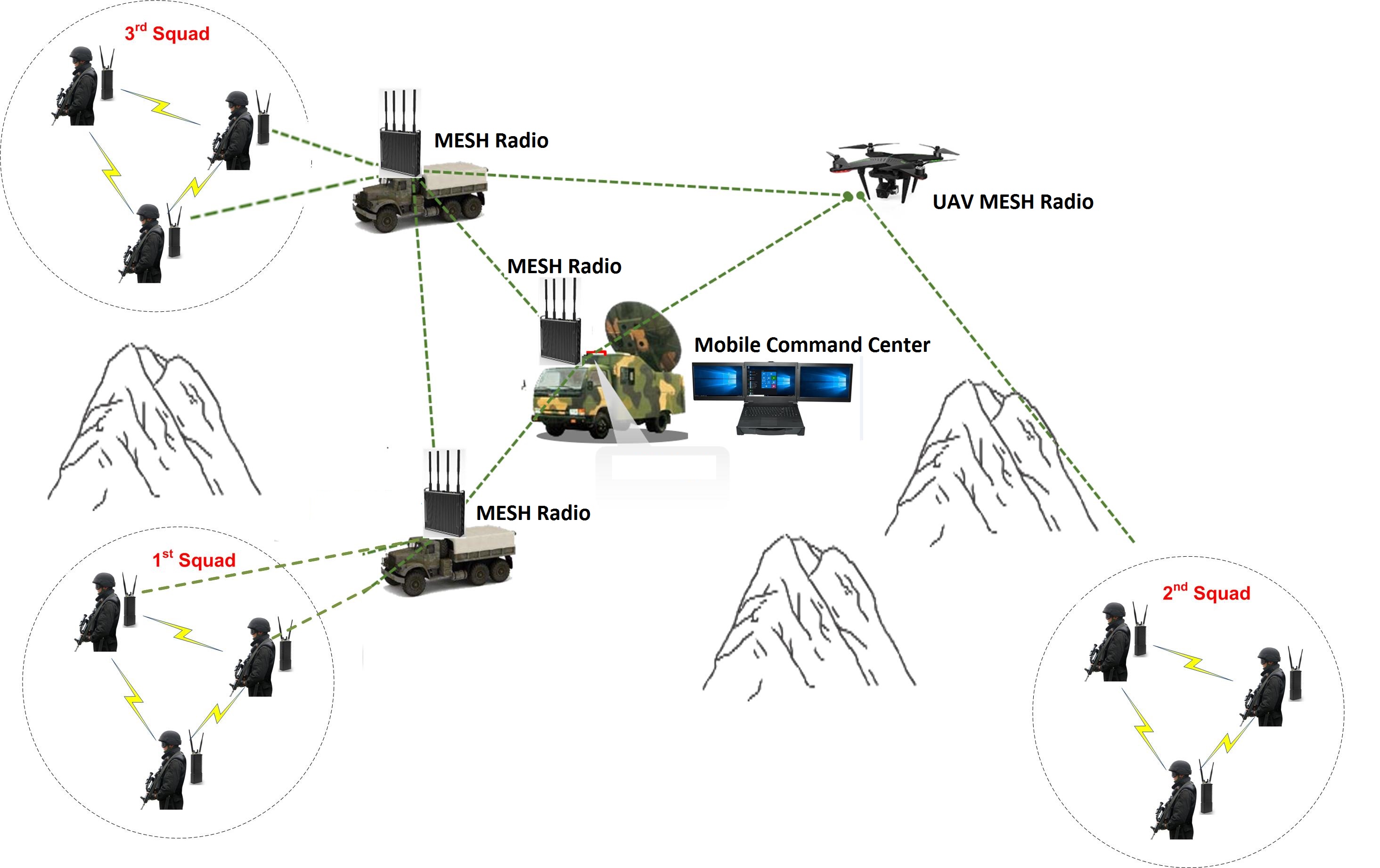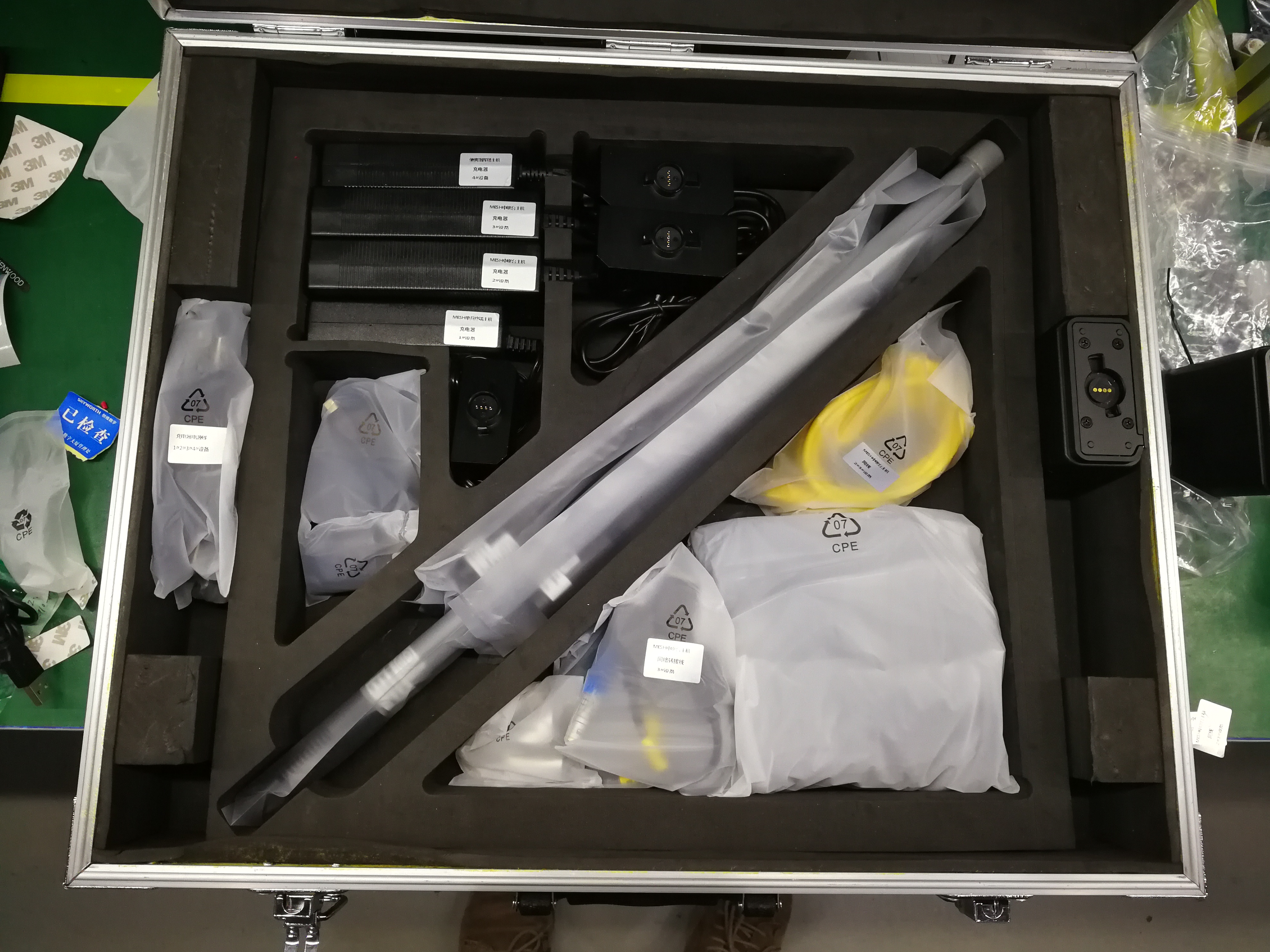LinkAV Technology Co., Ltd |
|
Verified Suppliers
|
|
IP66 MESH Radio for Police Military 4W MIMO 350MHz-4GHz Customizable
Introduction
IP Mesh Radio (MANET), 4W MIMO, IP66, removable battery with DC
charging port, with micro HDMI input, support intercom, 2.4/5.8G
WiFi and GPS, up to 80Mbps and 1-2km NLOS each hop.
The MANET2201 is a wireless IP mesh node, it can transmit audio,
video and IP data in real time, and its multi-hop relay can
increase the wireless transmission distance. Its self-organizing
network automatically selects the path, and the network mode is
flexible. It has strong anti-blocking and anti-interference
performance, and is very suitable for mobile communication under
complex environment. It can be applied to Public Security, Armed
Police, Fire Control, Civil Air Defense, Military, EOD Robot and
UGV to establish real-time and rapid communication and unified
coordination and command.
Features
■Infrastructure-less, self configuring and self healing
■Frequency 1400MHz-1480MHz (350MHz-4GHz customizable)
■Data rate up to 80Mbps
■Range up to 1-2km NLOS
■Supports up to 9 hops and no less than 50 nodes
■Full transparent IP data transmission
■Supports two-way intercom
■HDMI input as optional
■Supports 2.4G/5.8G WIFI connection
■Supports AES256 encryption
■Battery endurance up to 4-5 hours
■Rugged IP65 housing
■Low system latency
Specification
| Transmission Characteristics | |
| Frequency | 350MHz-4GHz customizable |
| Default Frequencies | 1400MHz-1480MHz |
| Channel Bandwidth | 2M/5M/10M/20MHz/40MHz |
| Output Power | 36dBm (4W MIMO 2x2) |
| WIFI | 2.4G/5.8G WIFI (2x100mw) |
| Modulation Type | DSSS/CCK BPSK/QPSK OFDM BPSK/QPSK/16-QAM/64-QAM |
| Digital Sensitivity | 96dBm@5MHz BPSK |
| Transmission Rate | Up to 80Mbps |
| Network Capability | 9 hops and no less than 50 nodes |
| Data Characteristics | |
| RF Interface | TNC F*2, SMA F*2 |
| LAN Interface | 9-Pin Lemo connector |
| Intercom Interface | 7-Pin Lemo connector |
| HDMI Interface(Optional) | Micro HDMI x1 |
| Signal Indicator | 1x LED dual color (Green/Red) |
| Encryption | 256-bit AES (user-defined password) |
| Electrical Characteristics | |
| Working Voltage | DC 16.8V |
| Power Consumption | ≤12W |
| Battery | 18.5V/3.5Ah |
| Physical Characteristics | |
| Weight | ≤1.2kg (w/ battery) |
| Dimensions | 265*90*40mm (w/battery) |
| IP Rating | IP65/IP66 |
| Storage Temp. | -45℃~85℃ |
| Working Temp. | -30℃~65℃ |
| Working Humidity | 5%-95% (Non-Condensing) |
Panel Description
① Signal Indicator
| Indicator Status | Signal Strength | |||
| Green still | Link is solid | |||
| Red/Green flicker intermittently | Link is going to break off | |||
| Red still | Can’t establish link | |||
| Red flickers | Link is not stable | |||
| SNR | Indicator Color | Flicker Frequency | Topology Color | Topology Value |
| 0 | Red | N/A | Green | 0 |
| 1-12 | Red flickers | 350ms | Green | 1-12 |
| 13-25 | Red/Green flicker | 350ms | Green | 13-25 |
| 26-35 | Green flickers | 350ms | Green | 26-35 |
| 36-70 | Green still | N/A | Green | 36-70 |
| >70 | Red flickers | 120ms | Green | >70 |
② Mic Input Interface
③ LAN Input Interface
④ WIFI Antenna Interface
⑤ Mesh Antenna Interface
⑥ Power Switch
⑦ GPS/BD Antenna Interface
⑧ Mesh Antenna Interface
Topology Diagram
■ Chain Type

■ Star Type
■ Mesh Type
■ Random Type
Tool Box Kit

Field Test
A MANET system is a group of mobile (or temporarily stationary)
devices which need to provide the ability to stream voice, data,
and video between arbitrary pairs of devices utilizing the others
as relays to avoid the need for infrastructure.
There are many techniques which are employed in order to provide
robust MANET capability, including the following:
Self-Forming / Self-Healing is a crucial characteristic of MANET systems. In a true mesh
network, radios can join or leave the network at any time, and the
network will continuously adapt its topology as nodes move in
relation to one another. This implies a decentralized architecture
in that there are no central “master” hub radios required to
administer control of the network, and communications will continue
to persist even when one or more nodes are lost.
Link Adaptation is the ability for each radio to optimally configure its
transmission parameters (constellation, FEC coding, and MIMO
techniques) to maximize the data rate and robustness of the links
to each of the other radios it is communicating with. A particular
radio may communicate with another close by radio using a data rate
of over 50 Mbps, while using a rate of only 2 Mbps to provide a
robust link to a radio much further away. These are packet burst
rates, where using a 50Mbps burst is very useful even for a much
lower rate data stream because it leaves free channel airtime for
other nodes in the network to use. Having high potential data burst
rates is important because the less airtime is consumed for the
shorter links, the more airtime is left to use slower and much more
robust modulation and coding on the distant links.
Adaptive Routing is a mechanism for determining which potential relay paths are
used when a stream of data needs to be sent between a given pair of
radios. It needs to support self-forming self-healing functionality
by adapting dynamically to use all radios present as potential
relays and be resilient to the loss of relaying radios. It must
also work in conjunction with the link adaptation because
determining the optimal route for a stream of data requires
consideration of other data which is flowing through the network,
as well as the dynamic capacity of each link within the network.
This problem is complex and requires all radios to share
information about the data traffic flowing through them and the
link capacity from each to the other neighboring nodes. This
sharing of information must be done in an intelligent manner so
that it does not consume too much of the precious available network
throughput.
Transparent IP Networking means that any number of standard computer, IP video camera or
other devices may be connected to each of the mobile radios and
communicate through the mesh network just as if all of the devices
were in a single office with wired Ethernet. There are different
ways this can be accomplished within the MANET. To enable the most
flexibility and ease of use, the best choice is to have the entire
MANET network appear as if it is a single Layer 2 networking
switch. This means that without any reconfiguration of IP addresses
or other settings, a group of IP based devices that work together
on a simple Ethernet switch can be connected to MANET radios and
resume operations with the new freedom of wireless mobility.
Multicast Traffic presents a set of unique challenges for MANET systems. The
multicast support implemented in basic wired Layer 2 switches is to
replicate multicast packets coming into one port on all of the
other ports. For instance, if an IP video camera is connected to
one port it would send its video using packets tagged as multicast.
Then computers wired to any of the other ports of the switch can
tap into the wireless video stream. This simplistic method turns
out to not work very well in a wireless network acting as a Layer 2
switch because many devices within the network might not need to
see a particular multicast, and blindly sending the multicast to
all devices thus congests the limited throughput of the wireless
network unnecessarily. More advanced MANET systems allow manual
and/or automatic optimization, limiting the transmission of
multicast to only those devices that need a particular multicast
stream.
Multi-channel Networks is an advanced capability of some MANET systems which allows a
network to utilize multiple RF channels or even multiple frequency
bands within a network while still providing the plug and play
functionality of a single Layer 2 switch. A simple example of the
usefulness of this might be a scenario where soldiers have radios
operating on one frequency while vehicles have radios not only
operating on that frequency but also ones in a different band. This
additional band might be with higher power or higher gain antennas
to provide a high speed “backbone” layer between the vehicles. Any
soldier’s radio device can communicate with any other soldier’s
radio over the air, but the secondary layer on a different
frequency can reduce congestion on the soldier frequency and
increase to area covered by the network.
All of these MANET networking capabilities combine to provide
robust high speed connectivity similar to what is offered by state
of the art 3G/4G networking, but in mission critical operational
scenarios where permanent wireless infrastructure is not available.